Termites – a pest dreaded by many homeowners. Relatively common in homes with wooden structures, drywood termites can cause significant damage to both homes and property. When struggling with a drywood termite infestation, time is of the essence. The longer termites are present and allowed to tunnel through wood in or around your home; the more damage may compound. So how does one get rid of a drywood termite infestation?
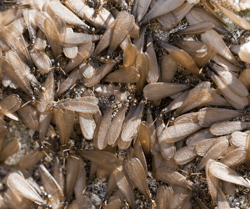 Drywood termites
Drywood termites
What are termites?
To better understand the intricacies of drywood termite removal, it’s important to better understand termites as a whole.
Subterranean Termites
Beginning with the most abundant of all termite species, Subterranean termites are commonplace in every U.S. state with the exception of Alaska. When most homeowners think of termites, they’re probably picturing the Subterranean termite. As their name suggests, these termites live primarily underground in large colonies and feast on any type of wood available to them. They also construct elaborate mud tunnels on the surface, thriving when in contact with moist soil or other water sources.
Drywood Termites
Unlike Subterranean Termites, Drywood Termites don't burrow deep into the moist soil for protection. In fact, they like much less moisture in their environment and food, preferring wood with a moisture content of 12% or less. Due to this, Drywood termites are common in areas with hot and dry climates like the Pacific coast, Central Valley, and the desert of Southern California. These termites enjoy hard and soft woods and live directly inside the wood they consume. Drywood termites are commonly found in the framing and structural supports of a home as well as personal property made of wood, such as furniture, photo frames, and more.
Dampwood Termites
Aptly named, Dampwood Termites flock to wood with high moisture content and live within the wood itself. Because homes are typically constructed with dry wood, Dampwood termites are not very common in most homes. That said, outdoor wooden structures that are exposed to regular moisture, such as fences or sheds are prime locations for Dampwood Termites to settle down! Due to their preference for a moist environment, Dampwood termites are most prevalent in the wetter Western or Southern states.
Formosan Termites
Considered a highly invasive species, Formosan Termites originated in China but have since invaded the southern United States. They are larger than most termite species and extremely aggressive in their destruction; a colony of Formosan Termites can consume more than an ounce of wood a day! Because they prefer a milder climate, Formosan Termites have become relatively common in the following U.S. states: Florida, Alabama, Georgia, Louisiana, Mississippi, South Carolina, North Carolina, Tennessee, Virginia, Texas, Arizona, California, and Hawaii.
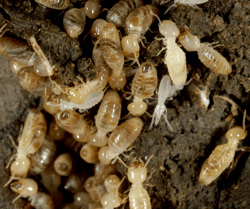 Subterranean termites in soil
Subterranean termites in soil
Do drywood termites cause damage?
Yes!
While generally not as destructive as subterranean termites, drywood termites are capable of causing significant damage to critical structural elements of a home and destroying personal property. Because they have no preference for hardwood or softwood, drywood termites will create larger, wider galleries than other species of termites. Due to their widespread galleries and tunnels, drywood termites are more likely to compromise the structural integrity of support beams, walls, and floors than subterranean termites. Additionally, because drywood termites live and colonize within wooden structures themselves, they may go undetected for years with little to no evidence of their presence. This furthers their ability to cause widespread damage without being discovered.
Often homeowners may be unaware of drywood termites in their home until entire structures collapse. In this way, drywood termites can be a more formidable pest than their “more destructive” cousin, subterranean termites.
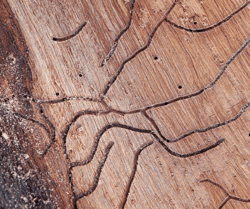 Drywood termite tunnels
Drywood termite tunnels
What are the signs of a drywood termite infestation?
Unfortunately, drywood termites can remain undetected in a home for years before damage becomes severe enough to become apparent to homeowners. Due to drywood termites’ ability to cause hidden but widespread damage, it is crucial to be on the lookout for early indicators of an infestation. Though difficult and sometimes nearly impossible to spot, there are a few indicators that may alert homeowners to the presence of drywood termites in their home.
- Drywood termites typically swarm after heavy rain and a rise in temperature. These swarms are new colonies in search of a nearby place to infest. Drywood termite swarms may appear outdoors or indoors – while it’s natural to assume a swarm spotted indoors came from outside, drywood termites are weak fliers and are more likely to have come from within the house. This may be indicative of an existing infestation within your home.
- Piles of wings or droppings. These are rarely obvious, but you may spot them caught in small spiderwebs or corners of your home. Unfortunately, drywood termites infesting your walls or attics may leave wings or droppings within the internal structures of your home. If this is the case, you likely won’t see these indicators at all.
- Small piles of frass-like sawdust. This is left behind as the drywood termites tunnel into wood and excavate structures, indicating their presence. Drywood termites may refrain from expelling frass or deposit it within walls or hidden holes, so it may not be visible to homeowners.
- Hollow sounding wood that had previously been solid. As drywood termites tunnel and build vast galleries, wooden structures may become hollow sounding when knocked on. Wood may also split or become soft to the touch as its integrity is compromised.
- Collapsed, broken, or failing wood structures. Ideally, the presence of drywood
termites would be identified prior to catastrophic damage. However, if a colony remains undetected for a few years, wooden structures may break and fail due to the extensive damage caused by drywood termites. If wooden structures in your home collapse or snap, inspect the wood thoroughly for termite damage and contact a trusted pest professional immediately for treatment.
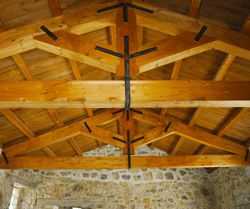 Example of wooden structural supports drywood termites may be attracted to
Example of wooden structural supports drywood termites may be attracted to
How do I get rid of drywood termites in my home?
Removing drywood termites from a home after an infestation has occurred should not be regarded as a DIY project. Due to drywood termites’ ability to infest critical areas of the home while invisible to the naked eye, we highly recommend seeking professional assistance in removing them from your home. The stakes are simply too high to leave drywood termite treatment to anyone other than experts.
At EcoShield Pest Solutions, we have professional-grade products and necessary expertise to treat your existing drywood termite infestation and prevent a recurring one. We understand that your home is your most precious investment and recognize that a severe drywood termite infestation may put you and your family at risk by compromising the integrity of important structural elements. With years of experience in professionally treating drywood termite infestations and proven techniques, EcoShield will ensure your home is termite-free and remains that way!
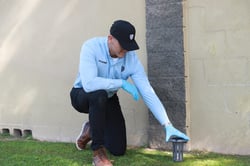 EcoShield pest technician installed a termite monitoring system
EcoShield pest technician installed a termite monitoring system
How can I prevent drywood termites?
At EcoShield, we believe in putting prevention first! It is much easier (and cheaper!) to prevent drywood termites from attacking your home than it is to attempt to remove and remediate drywood termite damage. A thorough inspection of your home will allow EcoShield pest technicians to identify potential problem areas and target them for treatment. With the Termite Shield Program, EcoShield offers year-round protection against termites and identifies potential termite activity before it becomes a headache. EcoShield’s proven strategy ensures the entire home is protected through the use of dependable products and with the informed knowledge of a termite’s habits, life cycle, and biology. Termite monitors will be installed every 15 feet to detect termite activity before it becomes catastrophic to your home and wallet.
If you’re experiencing a problem with termites in your home or would like to prevent termite damage in the future, call EcoShield today for a free, no-obligation quote.